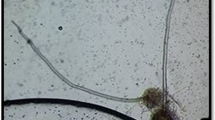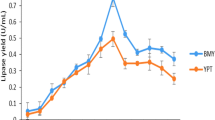Abstract
Current studies about lipase production by solid-state fermentation involve the use of agro-industrial residues towards developing cost-effective systems directed to large-scale commercialization of enzyme-catalyzed processes. In this work, lipase production and partial characterization of the crude enzymatic extracts obtained by Penicillium verrucosum using soybean bran as substrate was investigated. Different inductors were evaluated and the results showed that there is no influence of this variable on the lipase production, while temperature and initial moisture were the main factors that affected enzyme production. The optimized cultivation temperature (27.5 °C) and initial moisture of substrate (55%) were determined using the response surface methodology. Kinetics of lipase production was followed at the optimized growth conditions. Optimum lipase yield was 40 U/g of dry bran. The crude enzymatic extract showed optimal activity in the range from 30 to 45 °C and in pH 7.0.



Similar content being viewed by others
References
Sharma R, Chisti Y, Banerjee UC (2001) Production, purification, characterization, and applications of lipases. Biotechnol Adv 19:627–662
Lutz S (2004) Engineering lipase B from Candida antarctica. Tetrahedron Asymmetry 15(18):2743–2748
Mahadik ND, Puntambekar US, Bastawde KB, Khire JM, Gokhale DV (2002) Production of acidic lipase by Aspergillus niger in solid state fermentation. Process Biochem 38(5):715–721
Pandey A (2003) Solid-state fermentation. Biochem Eng J 13:81–84
Freire DMG, Teles EMF, Bon EPS, Sant’Anna Jr GL (1997) Lipase production by Penicillium restrictum in a laboratory scale fermentor: media composition, agitation and aeration. Appl Biochem Biotech 63:409–421
Castilho LR, Polato CMS, Baruque EA, Sant’Anna Jr GL, Freire DMG (2000) Economic analysis of lipase production by Penicillium restrictum in solid-state and submerged fermentations. Biochem Eng J 4:239–247
Leal MCMR, Cammarota MC, Freire DMG, Sant’Anna Jr GL (2002) Hydrolytic enzymes as coadjuvants in the anaerobic treatment of dairy wastewaters. Braz J Chem Eng 19:175–180
Pandey A, Soccol CR (2001) Solid state fermentation in biotechnology: fundamentals and applications. Asiatec Publishers, London, 221 p
Soccol CR, Vandenberghe LPS (2003) Overview of applied solid-state fermentation in Brazil. Biochem Eng J 13:205–218
Cordova J, Nemmaoui M, Ismaïli-Alaoui M, Morin A, Roussos S, Raimbault M, Benjilali B (1998) Lipase production by solid state fermentation of olive cake and sugar cane bagasse. J Mol Catal B Enzym 5:75–78
Muralidhar RV, Chirumamila RR, Marchant R, Nigam P (2001) A response surface approach for the comparison of lipase production by Candida cylindracea using two different carbon sources. Biochem Eng J 9:17–23
Di Luccio M, Capra F, Ribeiro NP, Vargas GDLP, Freire DMG, Oliveira D (2004) Effect of Temperature, moisture, and carbon supplementation on lipase production by solid-state fermentation of soy cake by Penicillium simplicissimum. Appl Biochem Biotech 113(1–3):173–180
Aidoo KE, Hendry R, Wood BJB (1981) Estimation of fungal growth in a solid state fermentation system. Appl Microbiol Biotechnol 12:6–9
Charney JE, Tomarelli RM (1947) A colorimetric method for the determination of the proteolytic activity of duodenal juice. J Biol Chem 171:501–505
Gombert AK, Pinto AL, Castilho LR, Freire DMG (2000) Lipase production by Penicillium restrictum in solid state fermentation using babassu oil cake as substrate. Process Biochem 35:85–90
Palma MB, Pinto AL, Gombert AK, Seitz KH, Kivatinitz SC, Castilho LR, Freire DMG (2000) Lipase production by Penicillium restrictum using solid waste of industrial babassu oil production as substrate. Appl Biochem Biotechnol 84–86:1137–1145
Shu C, Xu C, Lin G (2006) Purification and partial characterization of a lipase from Antrodia cinnamomea. Process Biochem 41:734–738
Cordova J, Nemmaoui M, Ismaïli-Alaoui M, Morin A, Roussos S, Raimbault M, Benjilali B (1998) Lipase production by solid state fermentation of olive cake and sugar cane bagasse. J Mol Catal B Enzym 5:75–78
Gervais P, Molin P (2003) The role of water in solid-state fermentation. Biochem Eng J 13:85–101
Gutarra MLE, Castilho LR, Freire DMG, Santanna Junior GL (2005) Lipase production by solid-state fermentation—cultivation conditions and operation of tray and packed-bed bioreactors. Appl Biochem Biotechnol 121:105–116
Kamini NR, Mala JGS, Puvanakrishnan R (1998) Lipase production from Aspergillus niger by solid-state fermentation using gingelly oil cake. Process Biochem 33:505–511
Benjamin S, Pandey A (2000) Isolation and characterization of three distinct forms of lipases from Candida rugosa produced in solid state fermentation. Brazil Arch Biol Technol 44:213–221
Pastore GM, Costa VSR, Koblitz MGB (2003) Purificação parcial e caracterização bioquímica de lipase extracelular produzida por uma nova linhagem de Rhizopus sp. Ciênc Tecnol Alimentos 23:135–140
Maia MMD, Morais MMC, Morais Jr MA, Melo EHM (1999) Lima Filho JL Production of extracellular lipase by the phytopathogenic fungus Fusarium solani FS1. Rev Microbiol 30:1–10
Burkert JFM, Maugeri F, Rodrigues MI (2004) Optimization of extracellular lipase production by Geotrichum sp. using factorial design. Bioresource Tech 91:74–84
Acknowledgments
The authors thank CAPES and CNPq for the financial support of this work and scholarships.
Author information
Authors and Affiliations
Corresponding author
Rights and permissions
About this article
Cite this article
Kempka, A.P., Lipke, N.L., da Luz Fontoura Pinheiro, T. et al. Response surface method to optimize the production and characterization of lipase from Penicillium verrucosum in solid-state fermentation. Bioprocess Biosyst Eng 31, 119–125 (2008). https://doi.org/10.1007/s00449-007-0154-8
Received:
Accepted:
Published:
Issue Date:
DOI: https://doi.org/10.1007/s00449-007-0154-8




